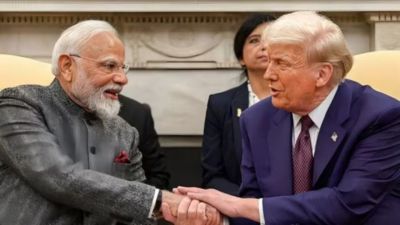Stay updated with the latest - Click here to follow us on Instagram
The sangathan mantri whom the BJP is wary of ‘talking up’
Rajendra Singh himself tries to douse the chief ministerial talk, at least in public. “Bhaiyya, chodo. Bahut ho gaya,” he told this reporter at Baripur village in Rohtas district.
 Rajendra Singh campaigns in Dinara with Bhojpuri singer Sonali. Prashant Ravi
Rajendra Singh campaigns in Dinara with Bhojpuri singer Sonali. Prashant Ravi
“The hope in the party is that the media won’t talk him up. If he becomes too famous, he could he ignored just for that,” said a BJP source who wished not to be identified.
BJP’s Dinara candidate Rajendra Singh, however, is already past that point. Various newspapers and channels have declared him the new Manohar Lal Khattar. There have even been comparisons to Narendra Modi — the list of sangathan mantris who became elected representatives is short and elite.
Rajendra Singh himself tries to douse the chief ministerial talk, at least in public. “Bhaiyya, chodo. Bahut ho gaya,” he told this reporter at Baripur village in Rohtas district.
Singh has no what-gave-me-away defence — if it was not party president Amit Shah talking him up, it must have been Union Home Minister Rajnath Singh’s campaign rally, or it could have been Jharkhand Chief Minister Raghubar Das travelling along when he submitted his nomination.
There’s the big one. “Modiji held only our candidate’s hand while introducing him during the (October 8) rally,” said Pawan Kumar of Karhansi village.
Some might say Singh needed the brute force that the big guns bring. “None of us knew who this man was. He dresses in a regular kurta-pyjama, takes a bath in two minutes, covers his head with a towel, like any Bihari, in the sun,” said Jitendra Prasad Singh, a former India Against Corruption member who now supports the BJP. Singh pointed to the sky. “Then, the helicopters came.”
Singh, 49, has never been politically active in his home state. Since his ABVP days, Singh has been in Uttar Pradesh. In 2013, he was appointed general secretary (organisation) of the BJP in Jharkhand.
The BJP’s sangathan mantris talk like BJP leaders, they sit at the BJP office, but they are really with the RSS. It is a deputation of sorts; they are seen as above party politics and are supposed to guide the organisation according to the RSS’s creed.
There was a feeling within the Jharkhand unit that Singh had crossed a threshold. “He should just join the party formally. For all practical purposes, he is a BJP man,” a leader, who himself progressed through the RSS ranks, had told this reporter in Jharkhand last November after a meeting with Singh ahead of the elections there. The leader had wanted a ticket and Singh, perceived to have Delhi’s ear, had shot down the idea.
Singh would go on to oversee the formation of an NDA government in the state. Earlier, Jharkhand had sent 12 BJP representatives to the Lok Sabha. Singh was rewarded this year by Shah with an inclusion in a four-member team tasked with preparing for the Bihar elections; he had the responsibility of the Patna-Magadh division. Later, his name featured in the first list of candidates.
At Dinara, it looks like Singh has been trying to replicate lessons from the Jharkhand campaign. There is a computer cell — manned by youngsters who say, “We are not from here” — that plans and executes campaign schedule, slogans such as “Vikas ka Nara, Rajendra Singh Dinara” on the walls and multiple committees stacked with RSS volunteers from UP to oversee operations. Singh makes it a point to travel in cars with Bihar number plates, but almost all cars outside his office are from Jharkhand.
The BJP has made it a fight about Dinara’s pride. This a region where Rajputs and Yadavs have contested to be the dominant caste. “We have never had a candidate like this,” is what Navlakha Rai, a BJP supporter, insists at Karhansi. He begins an argument with his cousin Krishna Rai over the credibility of Jai Kumar Singh, the JD(U) candidate.
The Rais are Rajputs; so are both candidates. The trouble for the BJP is that the JD(U) candidate, also the sitting MLA and cooperatives minister in the outgoing cabinet, has his reputation intact. Krishna Rai, for example, supports him for helping construct a concrete road through the village.







